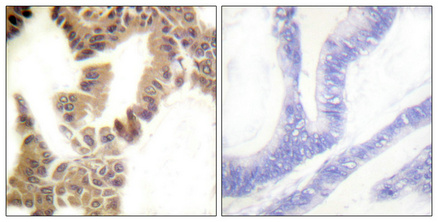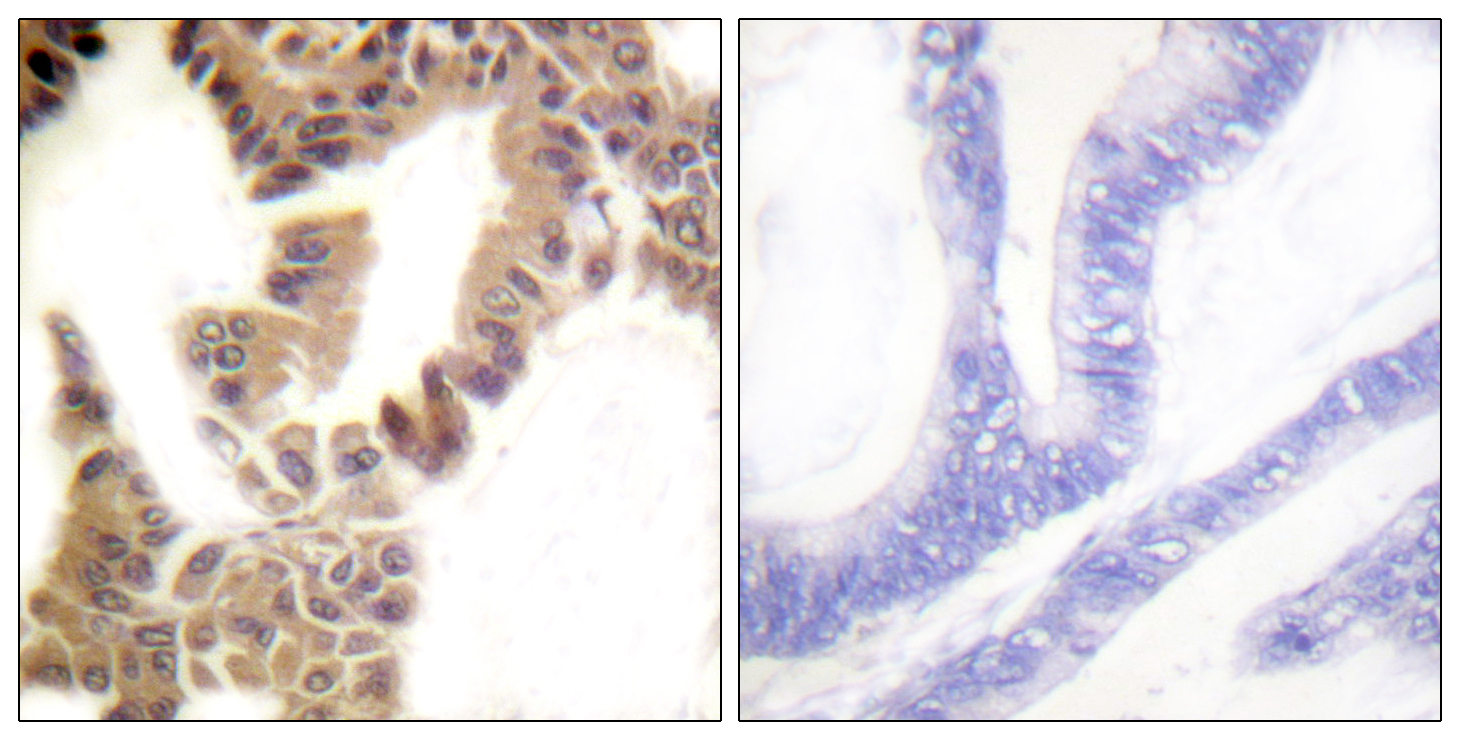Caspase-2 (phospho Ser157) Polyclonal Antibody
- Catalog No.:YP0997
- Applications:IHC;IF;ELISA
- Reactivity:Human;Rat;Mouse;
- Target:
- Caspase-2
- Fields:
- >>Apoptosis
- Gene Name:
- CASP2
- Protein Name:
- Caspase2
- Human Gene Id:
- 835
- Human Swiss Prot No:
- P42575
- Mouse Swiss Prot No:
- P29594
- Immunogen:
- The antiserum was produced against synthesized peptide derived from human Caspase 2 around the phosphorylation site of Ser157. AA range:123-172
- Specificity:
- Phospho-Caspase-2 (S157) Polyclonal Antibody detects endogenous levels of Caspase-2 protein only when phosphorylated at S157.
- Formulation:
- Liquid in PBS containing 50% glycerol, 0.5% BSA and 0.02% sodium azide.
- Source:
- Polyclonal, Rabbit,IgG
- Dilution:
- IHC 1:100 - 1:300. ELISA: 1:10000.. IF 1:50-200
- Purification:
- The antibody was affinity-purified from rabbit antiserum by affinity-chromatography using epitope-specific immunogen.
- Concentration:
- 1 mg/ml
- Storage Stability:
- -15°C to -25°C/1 year(Do not lower than -25°C)
- Other Name:
- CASP2;ICH1;NEDD2;Caspase-2;CASP-2;Neural precursor cell expressed developmentally down-regulated protein 2;NEDD-2;Protease ICH-1
- Molecular Weight(Da):
- 51kD
- Background:
- This gene encodes a member of the cysteine-aspartic acid protease (caspase) family. Caspases mediate cellular apoptosis through the proteolytic cleavage of specific protein substrates. The encoded protein may function in stress-induced cell death pathways, cell cycle maintenance, and the suppression of tumorigenesis. Increased expression of this gene may play a role in neurodegenerative disorders including Alzheimer's disease, Huntington's disease and temporal lobe epilepsy. Alternatively spliced transcript variants encoding multiple isoforms have been observed for this gene. [provided by RefSeq, Jan 2011],
- Function:
- alternative products:Isoforms differ in the N- and C-termini,catalytic activity:Strict requirement for an Asp residue at P1, with 316-asp being essential for proteolytic activity and has a preferred cleavage sequence of Val-Asp-Val-Ala-Asp-|-.,function:Involved in the activation cascade of caspases responsible for apoptosis execution. Might function by either activating some proteins required for cell death or inactivating proteins necessary for cell survival.,PTM:The mature protease can process its own propeptide, but not that of other caspases.,similarity:Belongs to the peptidase C14A family.,similarity:Contains 1 CARD domain.,subunit:Heterotetramer that consists of two anti-parallel arranged heterodimers, each one formed by a p18 subunit and a p12 subunit. Interacts with LRDD.,tissue specificity:Expressed at higher levels in the embryonic lung, liver and kidney than in the heart and b
- Subcellular Location:
- nucleus,cytoplasm,mitochondrion,cytosol,membrane,
- Expression:
- Expressed at higher levels in the embryonic lung, liver and kidney than in the heart and brain. In adults, higher level expression is seen in the placenta, lung, kidney, and pancreas than in the heart, brain, liver and skeletal muscle.
- June 19-2018
- WESTERN IMMUNOBLOTTING PROTOCOL
- June 19-2018
- IMMUNOHISTOCHEMISTRY-PARAFFIN PROTOCOL
- June 19-2018
- IMMUNOFLUORESCENCE PROTOCOL
- September 08-2020
- FLOW-CYTOMEYRT-PROTOCOL
- May 20-2022
- Cell-Based ELISA│解您多样本WB检测之困扰
- July 13-2018
- CELL-BASED-ELISA-PROTOCOL-FOR-ACETYL-PROTEIN
- July 13-2018
- CELL-BASED-ELISA-PROTOCOL-FOR-PHOSPHO-PROTEIN
- July 13-2018
- Antibody-FAQs
- Products Images

- Immunohistochemical analysis of paraffin-embedded Human lung cancer. Antibody was diluted at 1:100(4° overnight). High-pressure and temperature Tris-EDTA,pH8.0 was used for antigen retrieval. Negetive contrl (right) obtaned from antibody was pre-absorbed by immunogen peptide.

- Immunohistochemistry analysis of paraffin-embedded human lung carcinoma, using Caspase 2 (Phospho-Ser157) Antibody. The picture on the right is blocked with the phospho peptide.



